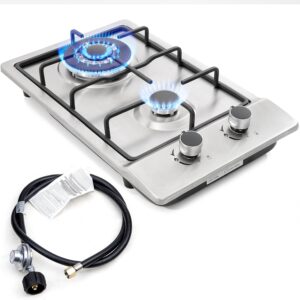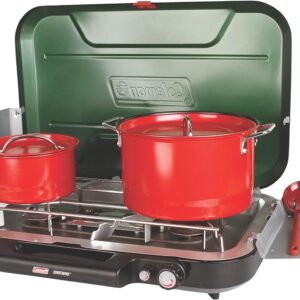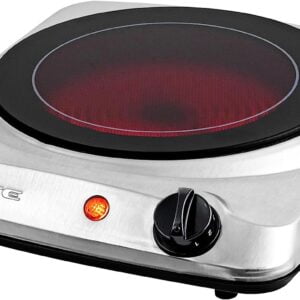Portable Propane Stoves
Showing all 6 results
-

Forimo 12-Inch Stainless Steel Gas Cooktop with 2 Burners, Drop-in Propane/Natural Gas Cooker, Dual Fuel 12″ Gas Stove Top for Easy Cleaning (12″W x 20″L)
$99.99 -

Forimo Portable Propane Gas Cooktop, Single Burner Stove with Auto Ignition, Tempered Glass, Ideal for Camping, RVs, Apartments, and Outdoor Cooking
$55.99 -

Koblenz Victoria 4-Burner Gas Stove, Bronze, 16,000 BTUs, 18″ x 24
$64.90 -
Sale!

Coleman Classic Portable 3-Burner Propane Camping Stove, Instant Ignition, Wind Guards, Pressure Control, Carry Handle – 28,000 BTUs
Original price was: $179.99.$158.00Current price is: $158.00. -
Sale!

Gas One GS-3400P Portable Dual Fuel Stove – Propane and Butane Compatible – Camping Grill/Stove with Carrying Case, Adjustable Burners, and Wind Guards
Original price was: $32.99.$30.69Current price is: $30.69. -

Coleman Triton+ 2-Burner Propane Camping Stove, Portable Grill/Stove with Adjustable Burners, Instant Push-Button Ignition, Wind Guards, and a Total of 22,000 BTUs of Cooking Power
$109.99
Guide to Portable Propane Stoves
Portable propane stoves are versatile cooking appliances that use propane gas for outdoor cooking. They are popular among campers, hikers, tailgaters, and anyone who enjoys outdoor activities. Here’s a comprehensive guide to help you understand and make the most of your portable propane stove:
1. Advantages of Portable Propane Stoves:
Portability: These stoves are designed to be lightweight and compact, making them easy to carry and transport, especially during camping trips or picnics.
Convenience: Propane stoves are quick to set up and ignite, allowing you to start cooking almost instantly.
Consistent Heat: Propane stoves provide consistent and adjustable heat levels, allowing precise control over your cooking.
Wide Availability: Propane canisters are widely available at camping stores, gas stations, and outdoor retailers.
2. Choosing the Right Stove:
Single Burner vs. Multiple Burners: Decide whether you need a single burner stove for solo adventures or a multiple burner stove for group cooking.
BTU Output: Consider the BTU output of the stove. Higher BTU means more heat, leading to faster cooking times, but it may also consume fuel more quickly.
Ignition System: Look for stoves with built-in piezo igniters, as they eliminate the need for matches or lighters.
Wind Resistance: Check if the stove has windshields or wind guards to improve performance in windy conditions.
Fuel Compatibility: Ensure that the stove is compatible with standard propane canisters or any other type of fuel you prefer.
3. Setting up the Stove:
Safe Location: Place the stove on a stable, flat surface away from flammable materials and well-ventilated areas. Never use it indoors or in confined spaces.
Connecting the Propane Canister: Carefully attach the propane canister to the stove following the manufacturer’s instructions. Make sure it is secure and leak-free.
Check for Leaks: Before igniting the stove, perform a leak test by applying a soapy water solution to the connections and hoses. If you spot any bubbles, there’s a leak, and you should address it before using the stove.
Open the Gas Valve: Slowly open the gas valve on the stove to allow the propane to flow.
4. Igniting and Operating the Stove:
Piezo Ignition: If your stove has a piezo igniter, turn the burner knob to the “ignite” position, and it will create a spark to light the gas.
Manual Ignition: For stoves without an integrated ignition system, use a long-reach lighter or matches to ignite the gas. Hold the flame close to the burner while slowly turning on the gas until it ignites.
Flame Control: Adjust the burner knobs to regulate the flame size. Higher settings produce more heat, while lower settings reduce heat output.
5. Safety Tips:
Supervision: Never leave a lit stove unattended, especially if there are children or pets around.
Ventilation: Always use the stove in a well-ventilated area to prevent the buildup of carbon monoxide.
Stability: Ensure that the stove is stable on the ground or on a flat surface to avoid accidental tipping.
Cool Down and Storage: Allow the stove to cool down completely before handling or storing it.
Follow Manufacturer’s Guidelines: Adhere to all safety instructions and guidelines provided by the stove’s manufacturer.
6. Cleaning and Maintenance:
Regular Cleaning: Clean the stove after each use to remove grease, food residue, and debris.
Inspect for Damage: Regularly inspect the stove for any signs of wear, damage, or gas leaks.
Store Properly: When not in use, store the stove in a cool, dry place, away from direct sunlight and moisture.
By following these guidelines, you can safely and efficiently use your portable propane stove to prepare delicious meals during your outdoor adventures. Remember, safety is paramount, so always exercise caution and prioritize safety while using your stove.






